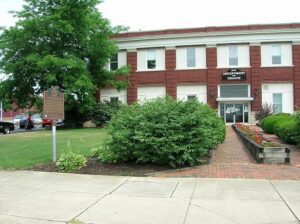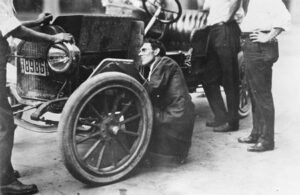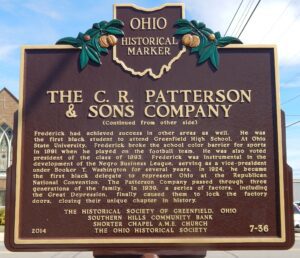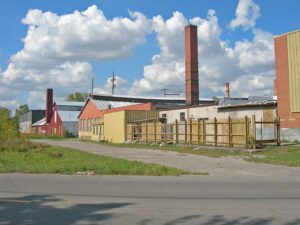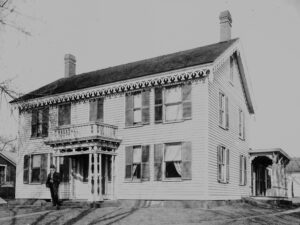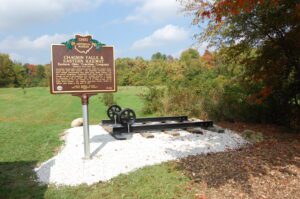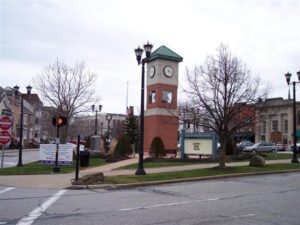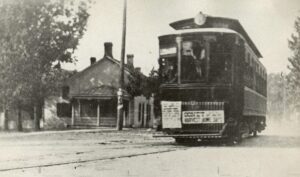, OH
In 1910, the Ohio Electric Railway Company opened this terminal, formerly the Interurban Building, which served interurban passengers until 1937. Along with offices, it contained space for express and baggage handling, ticket windows, a newsstand, a lunch counter, and waiting rooms. Three tracks were laid at the rear of the building. At its peak, Ohio Electric radiated from Lima to Springfield, Toledo (via Ottawa), Defiance, and Fort Wayne. Its competitor, The Western Ohio Railway (“Lima Route”) connected Dayton and Toledo (via Findlay). The interurban network in and around Lima led to the creation of suburbs, linked industrial and residential areas, and promoted the creation of amusement parks and small lake resorts. With decreased passenger traffic due in part to personal automobiles and the Great Depression, the interurban and street railway era in Lima ended in 1939, 52 years after it had begun as Ohio’s first successful electric streetcar system.
, OH
Charles F. “Boss” Kettering was a prolific inventor. While at National Cash Register, he invented the first electric cash register. Kettering founded the Dayton Engineering Laboratories Company (Delco) in 1909 and developed the electric self-starter for automobiles, first used in 1912 Cadillacs. He also developed no-knock Ethyl gasoline, lacquer car finishes, four-wheel brakes, safety glass, and high-compression engines; made significant improvements to diesel engines that led to their use in locomotives, trucks, and buses; and collaborated with Thomas Midgley, Jr. in the development of the refrigerant Freon. Kettering served as President of the Society of Automotive Engineers in 1918, co-founded the Engineers’ Club of Dayton (1914), and was director of research at General Motors Corporation from 1920 to 1947. His interest in medical and scientific research led to the founding of the Kettering Foundation and the Sloan-Kettering Institute for Cancer Research.
, OH
The factory of the C. R. Patterson & Sons Company once stood near here at 138 N. Washington Street. Established in the mid-nineteenth century by the black businessman Charles Richard (C. R.) Patterson and his white partner, J. P. Lowe, the business, originally known as J. P. Lowe & Company, became a successful carriage firm. Patterson became the sole owner in 1893 and changed the name to C. R. Patterson & Sons. After succeeding his father as owner, C. R.’s son, Frederick, became the first known African-American automobile manufacturer. Under his leadership, the company transitioned from building carriages to automobiles, then to trucks and buses to keep up with the changing demands of the transportation industry. (Continued on other side)
, OH
First organized as the Kenton Lock Manufacturing Company in 1890, the Kenton Hardware Company became one of the world’s largest cast iron toy factories. Under the management of L.S. Bixler, toy stoves, banks, fire company outfits, horse drawn vehicles, automobiles and cap pistols were produced. The immensely popular Gene Autry cap pistol was produced at this plant beginning in 1938. The Company ceased production in 1952 but Kenton toys continue to be popular collectors items worldwide.
, OH
The Johnson House was built in 1852 and its first owner was Henry J. Traver (1827-1911), owner of Traver & Company carriage factory across the street. From 1877 until 1994 the house was the residence and office of four doctors who maintained their practices there. The first was Dr. Daniel Cranz (1854 — 1914); followed by Dr. Thomas Ritter (1855—1928). In 1900, Dr. Robert Johnson (1878 — 1952) purchased the house. His daughter Dr. Myra Johnson (1909 — 1994) took over the practice after he died and until she retired in 1976. After her death, the house was converted into a museum. It is operated by the Wadsworth Area Historical Society and owned by the City of Wadsworth. (Continued on other side)
, OH
From east to west, the Chagrin Falls and Eastern Interurban Railway crossed the Muggleton Farm (now South Russell Village Park) at this location and connected the Chagrin Valley with Hiram, Garrettsville, and Middlefield. Its sister interurban, the Cleveland and Chagrin Falls Electric Railway served points west. Soon after their formation, the Everett-Moore Syndicate merged the two lines into the extensive interurban rail network, The Eastern Ohio Traction Company. The EOTC and its predecessors operated from 1899-1925, mainly moving mail, farm goods, and passengers. In 1914, the more rural line from Chagrin Falls traveling eastward became the first major interurban in the United States to cease operations. It is believed that declining use, insufficient power for the railway, and a failed line extension to Youngstown were likely factors contributing to the line’s demise.(Continued on other side)
, OH
The Triangle, one of the most historic places in Berea, has been the center of the city’s civic life since the mid-19th century. Just beneath lie the solid layers of the famous Berea Sandstone that brought prosperity to Berea during its early years. Quarry owner and Berea Seminary founder John Baldwin obtained much of what is now Berea from Gideon Granger, Postmaster General under President Thomas Jefferson and original owner of Township 6, Range 14 (later Middleburg Township) of the Western Reserve. When the seminary trustees transferred the Triangle tract to the people of Berea in 1847, they designated it by deed as a public promenade. This farsighted stipulation preserved it from commercial development during the 20th century. (continued on other side)
, OH
The Rapid Railway began operation in 1903 and was the Interurban Railway and Terminal Company’s (IR&T) northernmost traction line. The IR&T began near Pleasant Ridge and Kennedy Heights in Cincinnati and connected to a street car line that originated downtown, on Sycamore Street, and passed through a total of fourteen municipalities. The interurban cars ran down Main Street through Mason before turning south onto Dawson Street, crossing Muddy Creek, and traveling to Kings Mills. From Kings Mills, the line continued to Lebanon where it terminated. The full ride from downtown Cincinnati to Lebanon took approximately one hour and fifty minutes. (Continued on other side)


